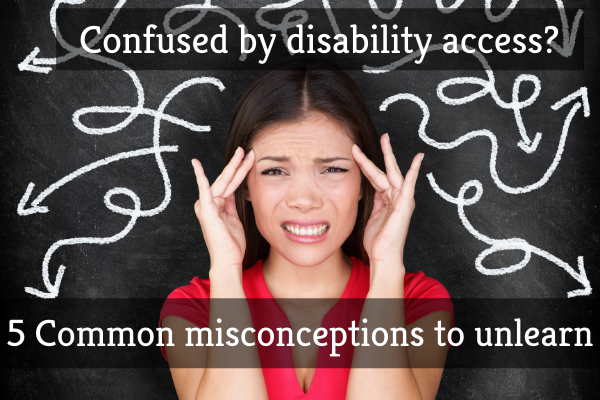Understanding law and how it affects a person, especially when that person is not yourself, is a challenge in any situation. It often feels like disability law is some of the most confusing out there! About a year ago, I contacted my LegalShield attorney to help me understand the basics of the Americans with Disabilities Act, at least in regards to access to public buildings, etc. If I was going to advocate for accessibility, I wanted to be armed with accurate information!

I turns out that even I had some misconceptions about what the ADA does and does not say.
5 of the biggest misconceptions
Access is still a big problem
The biggest thing I get asked/challenged about is the fact that things remain inaccessible. To be clear: The Americans With Disabilities Act is an amazing piece of legislation and I am forever grateful to President Bush for making it happen almost 31 years ago.
BUT… it’s not enough. For one, it allows too many loopholes. “Historic” places are exempt, churches get a lot of exemptions and loopholes, and in general (this is the part most don’t seem to comprehend or believe), there are so many loopholes for renovated buildings that the law feels almost pointless. For example, business owners can say they can’t afford the renovations and it’s declared a hardship. That means they are exempt. That means they are allowed to discriminate against 26 percent (if not more) of the general population.
One misconception about a “loopholes” I had is that some businesses are “grandfathered” in. That’s not true. Every public place is required to be accessible. There are just too many other loopholes that allows for some to remain inaccessible.
It’s a hard fight
Another common misconception is that the fixes are easy to make happen. Not even close. It takes an expensive and troublesome lawsuit and that’s if you get that far. I can’t tell you how many times I’ve been treated rudely and even with a great deal of hostility from managers, building owners, and business employees when I politely let them know there is an access issue. And you know what? Most f the time the problems are really obvious like stairs or blocking handicap parking.
From what I understand, recent changes to the law make getting anything accomplished with a lawsuit even more difficult. I get wanting to guard against frivolous lawsuits. But other laws and standards against those should be enough. Quit using that as a lame excuse to not protect people and promote good business.
New doesn’t mean accessible
Another common misconception is that just because a building is new that it’s automatically accessible. Yes, it must fit ADA standards. But that’s where the stupid human factor comes in. I can’t tell you how many times handicap stalls have been used as storage, hallways are blocked by stuff that hasn’t been put away or items like highchairs, and doorways are blocked by trashcans, etc. It does no one any good to have accessible features in a building if humans do things to make those spaces inaccessible (another blog on this coming soon).
A label doesn’t make it accessible
Another misconception is that just because someone says something is accessible or you see that little wheelchair symbol doesn’t make it true. The initial standards for the ADA were way too lax so updates have fixed those. There are many buildings where it is labeled accessible and perhaps the bathroom stall or whatever is, but that doesn’t matter if a wheelchair that fits the guidelines still can’t get through the door.
These are not workarounds or “fixes”
Lastly, to address common “fixes” that people suggest:
- Offering to “have someone from the kitchen” or someone else from the business carry the person inside or to otherwise force them to leave their wheelchair to enter the building or get into the bathroom is never acceptable. It’s demeaning, it’s dangerous for everyone involved, and it is a horrible attempt to negate the business’ responsibility to make things safe for all.
- Some people have differing opinions on this, but offering to serve a person outside when there is no outside seating is just ignorant. I’ve had restaurants say they could hand me the food through the door and I could eat on the ledge like they were being super helpful and kind. No.
- Not really a fix, but I have heard a lot of business owners say they don’t need to be accessible because disabled people don’t visit their store. They don’t visit because they can’t. The fact that this needs to be explained still blows my mind.
Something to think about
I’m sure many are tired of hearing about this, but 26 percent of the population (if not more) is tired of living it. The ADA is more than 30 years old and it’s time people start paying attention. It’s time that the abled world gets it head out of the sand and quits being part of the problem.
Think about this: I assume most of my friends would never patronize a business that blatantly made it impossible for only one gender or one race to patronize that business. Why do you continue patronizing and excusing businesses that only allow non-disabled people to be a customer by nature of being inaccessible?
